door lock CHEVROLET AVEO 2002 Service Repair Manual
[x] Cancel search | Manufacturer: CHEVROLET, Model Year: 2002, Model line: AVEO, Model: CHEVROLET AVEO 2002Pages: 5127, PDF Size: 41.82 MB
Page 1444 of 5127
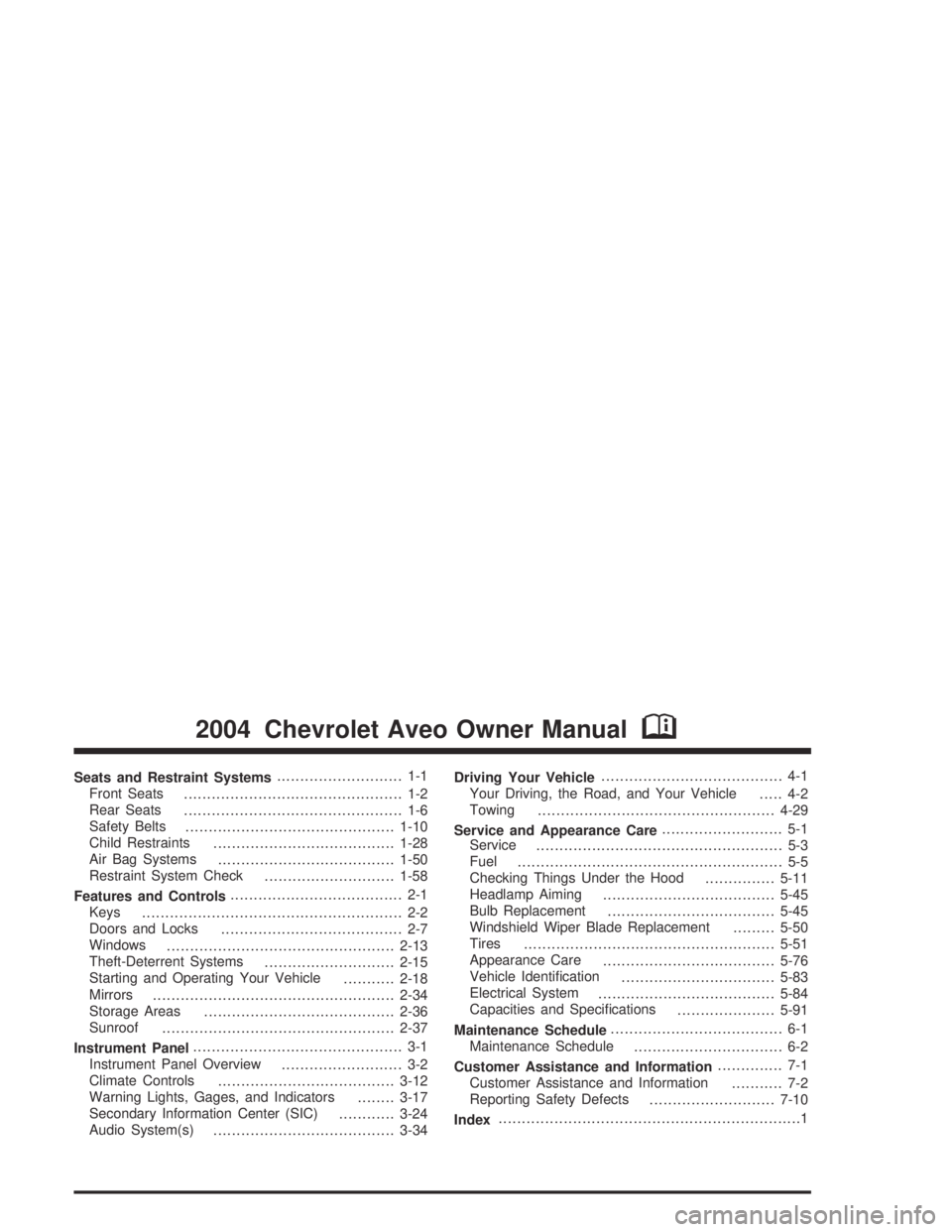
Seats and Restraint Systems........................... 1-1
Front Seats
............................................... 1-2
Rear Seats
............................................... 1-6
Safety Belts
.............................................1-10
Child Restraints
.......................................1-28
Air Bag Systems
......................................1-50
Restraint System Check
............................1-58
Features and Controls..................................... 2-1
Keys
........................................................ 2-2
Doors and Locks
....................................... 2-7
Windows
.................................................2-13
Theft-Deterrent Systems
............................2-15
Starting and Operating Your Vehicle
...........2-18
Mirrors
....................................................2-34
Storage Areas
.........................................2-36
Sunroof
..................................................2-37
Instrument Panel............................................. 3-1
Instrument Panel Overview
.......................... 3-2
Climate Controls
......................................3-12
Warning Lights, Gages, and Indicators
........3-17
Secondary Information Center (SIC)
............3-24
Audio System(s)
.......................................3-34Driving Your Vehicle....................................... 4-1
Your Driving, the Road, and Your Vehicle
..... 4-2
Towing
...................................................4-29
Service and Appearance Care.......................... 5-1
Service
..................................................... 5-3
Fuel
......................................................... 5-5
Checking Things Under the Hood
...............5-11
Headlamp Aiming
.....................................5-45
Bulb Replacement
....................................5-45
Windshield Wiper Blade Replacement
.........5-50
Tires
......................................................5-51
Appearance Care
.....................................5-76
Vehicle Identification
.................................5-83
Electrical System
......................................5-84
Capacities and Specifications
.....................5-91
Maintenance Schedule..................................... 6-1
Maintenance Schedule
................................ 6-2
Customer Assistance and Information.............. 7-1
Customer Assistance and Information
........... 7-2
Reporting Safety Defects
...........................7-10
Index.................................................................1
2004 Chevrolet Aveo Owner ManualM
Page 1464 of 5127
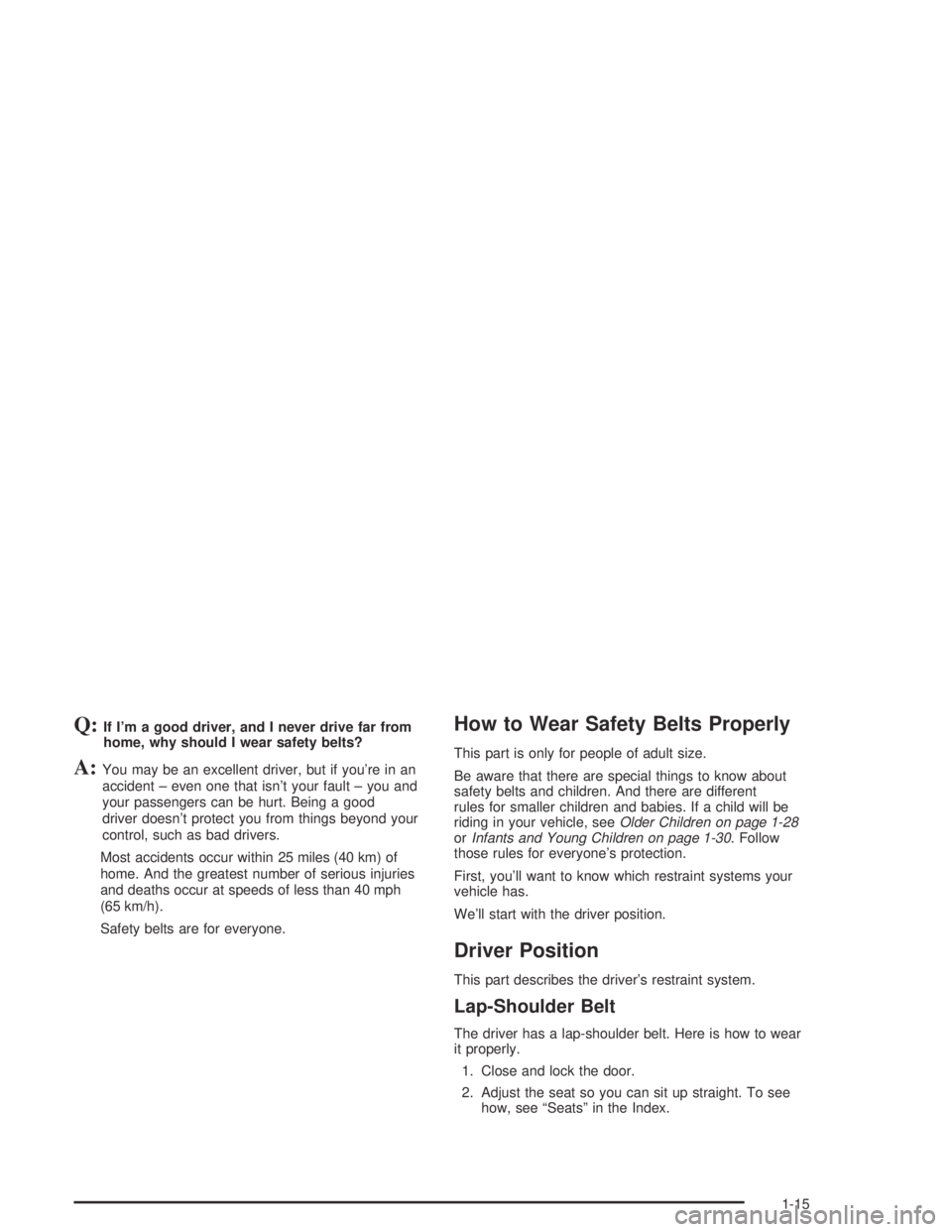
Q:If I’m a good driver, and I never drive far from
home, why should I wear safety belts?
A:You may be an excellent driver, but if you’re in an
accident – even one that isn’t your fault – you and
your passengers can be hurt. Being a good
driver doesn’t protect you from things beyond your
control, such as bad drivers.
Most accidents occur within 25 miles (40 km) of
home. And the greatest number of serious injuries
and deaths occur at speeds of less than 40 mph
(65 km/h).
Safety belts are for everyone.
How to Wear Safety Belts Properly
This part is only for people of adult size.
Be aware that there are special things to know about
safety belts and children. And there are different
rules for smaller children and babies. If a child will be
riding in your vehicle, seeOlder Children on page 1-28
orInfants and Young Children on page 1-30. Follow
those rules for everyone’s protection.
First, you’ll want to know which restraint systems your
vehicle has.
We’ll start with the driver position.
Driver Position
This part describes the driver’s restraint system.
Lap-Shoulder Belt
The driver has a lap-shoulder belt. Here is how to wear
it properly.
1. Close and lock the door.
2. Adjust the seat so you can sit up straight. To see
how, see “Seats” in the Index.
1-15
Page 1503 of 5127
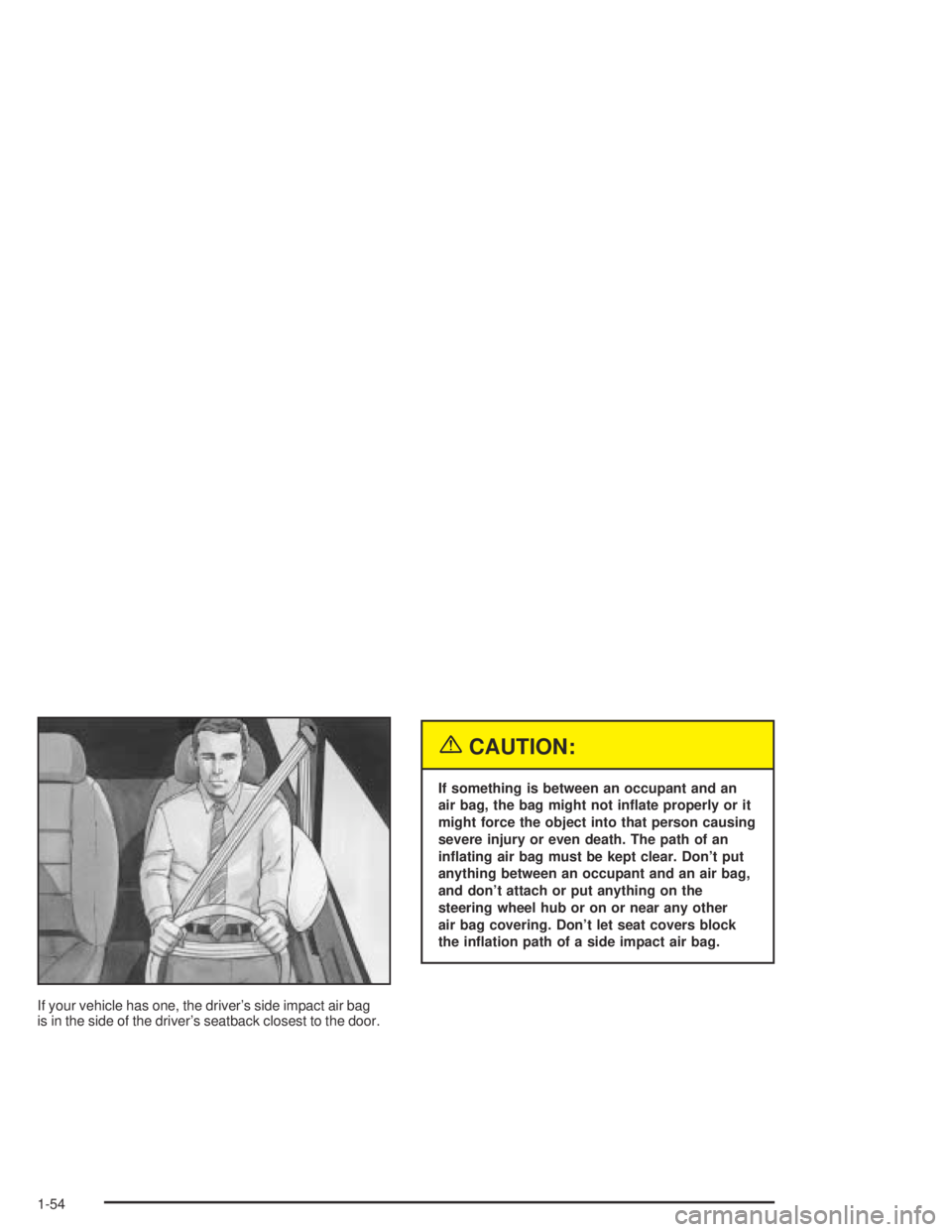
If your vehicle has one, the driver’s side impact air bag
is in the side of the driver’s seatback closest to the door.
{CAUTION:
If something is between an occupant and an
air bag, the bag might not in�ate properly or it
might force the object into that person causing
severe injury or even death. The path of an
in�ating air bag must be kept clear. Don’t put
anything between an occupant and an air bag,
and don’t attach or put anything on the
steering wheel hub or on or near any other
air bag covering. Don’t let seat covers block
the in�ation path of a side impact air bag.
1-54
Page 1510 of 5127
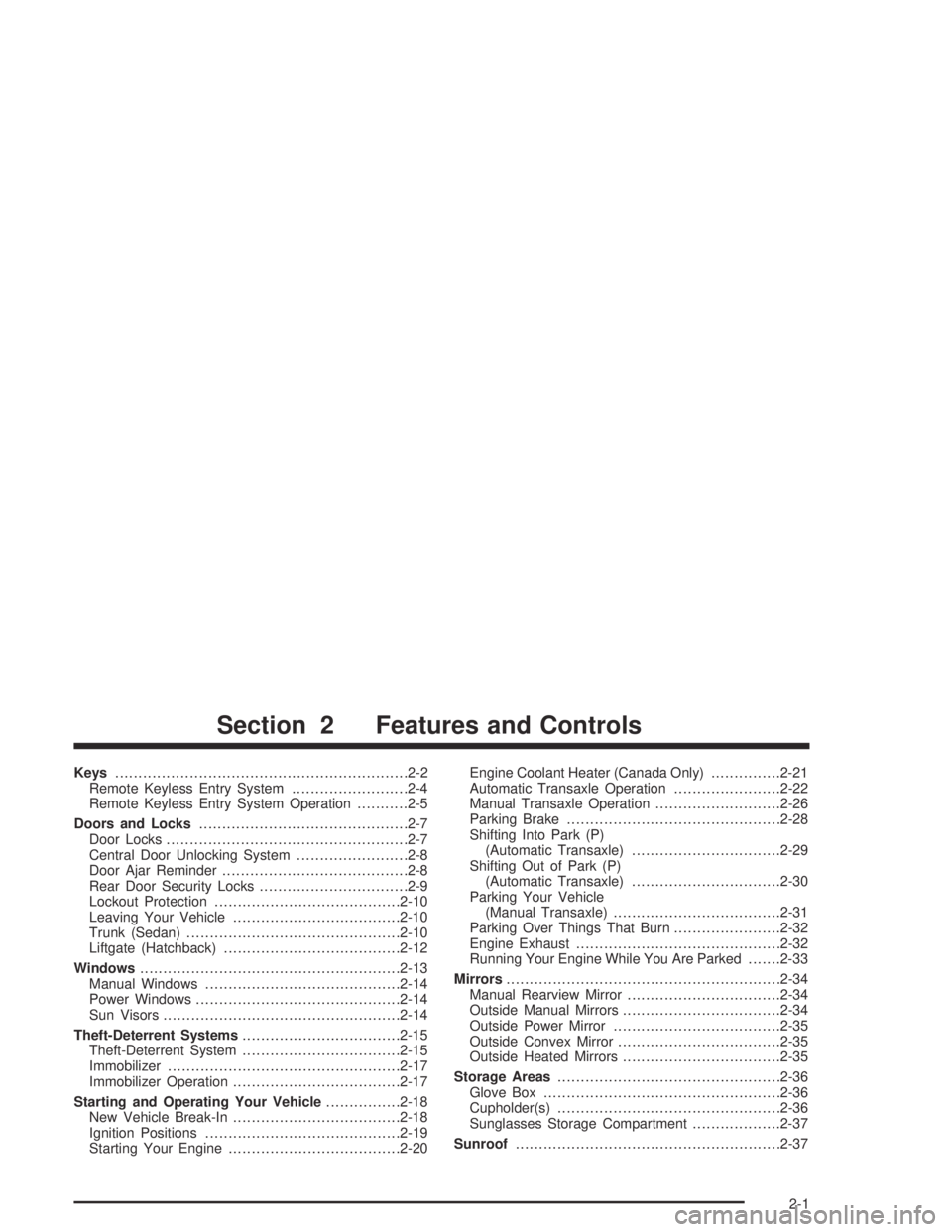
Keys...............................................................2-2
Remote Keyless Entry System.........................2-4
Remote Keyless Entry System Operation...........2-5
Doors and Locks.............................................2-7
Door Locks....................................................2-7
Central Door Unlocking System........................2-8
Door Ajar Reminder........................................2-8
Rear Door Security Locks................................2-9
Lockout Protection........................................2-10
Leaving Your Vehicle....................................2-10
Trunk (Sedan)..............................................2-10
Liftgate (Hatchback)......................................2-12
Windows........................................................2-13
Manual Windows..........................................2-14
Power Windows............................................2-14
Sun Visors...................................................2-14
Theft-Deterrent Systems..................................2-15
Theft-Deterrent System..................................2-15
Immobilizer..................................................2-17
Immobilizer Operation....................................2-17
Starting and Operating Your Vehicle................2-18
New Vehicle Break-In....................................2-18
Ignition Positions..........................................2-19
Starting Your Engine.....................................2-20Engine Coolant Heater (Canada Only)...............2-21
Automatic Transaxle Operation.......................2-22
Manual Transaxle Operation...........................2-26
Parking Brake..............................................2-28
Shifting Into Park (P)
(Automatic Transaxle)................................2-29
Shifting Out of Park (P)
(Automatic Transaxle)................................2-30
Parking Your Vehicle
(Manual Transaxle)....................................2-31
Parking Over Things That Burn.......................2-32
Engine Exhaust............................................2-32
Running Your Engine While You Are Parked.......2-33
Mirrors...........................................................2-34
Manual Rearview Mirror.................................2-34
Outside Manual Mirrors..................................2-34
Outside Power Mirror....................................2-35
Outside Convex Mirror...................................2-35
Outside Heated Mirrors..................................2-35
Storage Areas................................................2-36
Glove Box...................................................2-36
Cupholder(s)................................................2-36
Sunglasses Storage Compartment...................2-37
Sunroof.........................................................2-37
Section 2 Features and Controls
2-1
Page 1512 of 5127
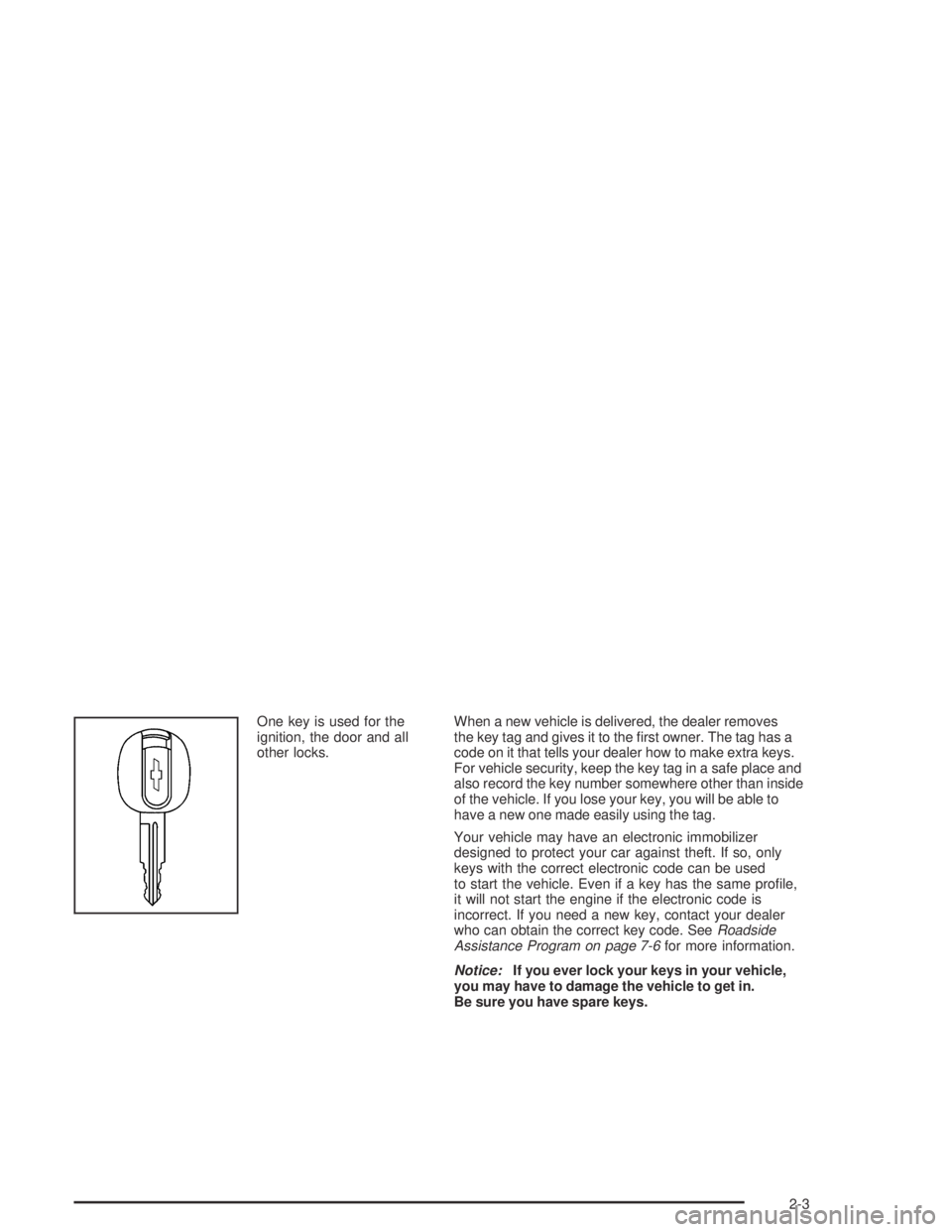
One key is used for the
ignition, the door and all
other locks.When a new vehicle is delivered, the dealer removes
the key tag and gives it to the first owner. The tag has a
code on it that tells your dealer how to make extra keys.
For vehicle security, keep the key tag in a safe place and
also record the key number somewhere other than inside
of the vehicle. If you lose your key, you will be able to
have a new one made easily using the tag.
Your vehicle may have an electronic immobilizer
designed to protect your car against theft. If so, only
keys with the correct electronic code can be used
to start the vehicle. Even if a key has the same profile,
it will not start the engine if the electronic code is
incorrect. If you need a new key, contact your dealer
who can obtain the correct key code. SeeRoadside
Assistance Program on page 7-6for more information.
Notice:If you ever lock your keys in your vehicle,
you may have to damage the vehicle to get in.
Be sure you have spare keys.
2-3
Page 1514 of 5127
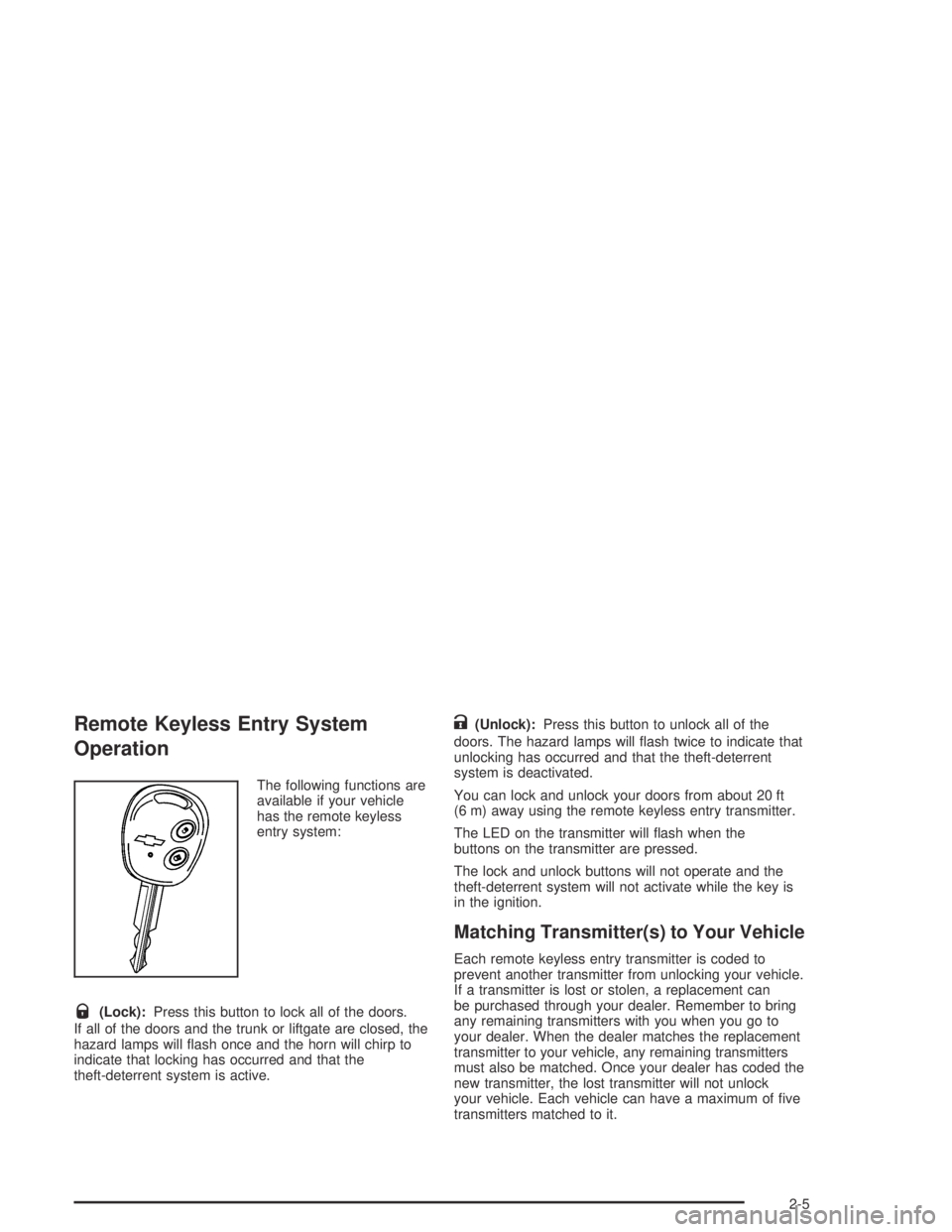
Remote Keyless Entry System
Operation
The following functions are
available if your vehicle
has the remote keyless
entry system:
Q(Lock):Press this button to lock all of the doors.
If all of the doors and the trunk or liftgate are closed, the
hazard lamps will flash once and the horn will chirp to
indicate that locking has occurred and that the
theft-deterrent system is active.
K(Unlock):Press this button to unlock all of the
doors. The hazard lamps will flash twice to indicate that
unlocking has occurred and that the theft-deterrent
system is deactivated.
You can lock and unlock your doors from about 20 ft
(6 m) away using the remote keyless entry transmitter.
The LED on the transmitter will flash when the
buttons on the transmitter are pressed.
The lock and unlock buttons will not operate and the
theft-deterrent system will not activate while the key is
in the ignition.
Matching Transmitter(s) to Your Vehicle
Each remote keyless entry transmitter is coded to
prevent another transmitter from unlocking your vehicle.
If a transmitter is lost or stolen, a replacement can
be purchased through your dealer. Remember to bring
any remaining transmitters with you when you go to
your dealer. When the dealer matches the replacement
transmitter to your vehicle, any remaining transmitters
must also be matched. Once your dealer has coded the
new transmitter, the lost transmitter will not unlock
your vehicle. Each vehicle can have a maximum of five
transmitters matched to it.
2-5
Page 1516 of 5127
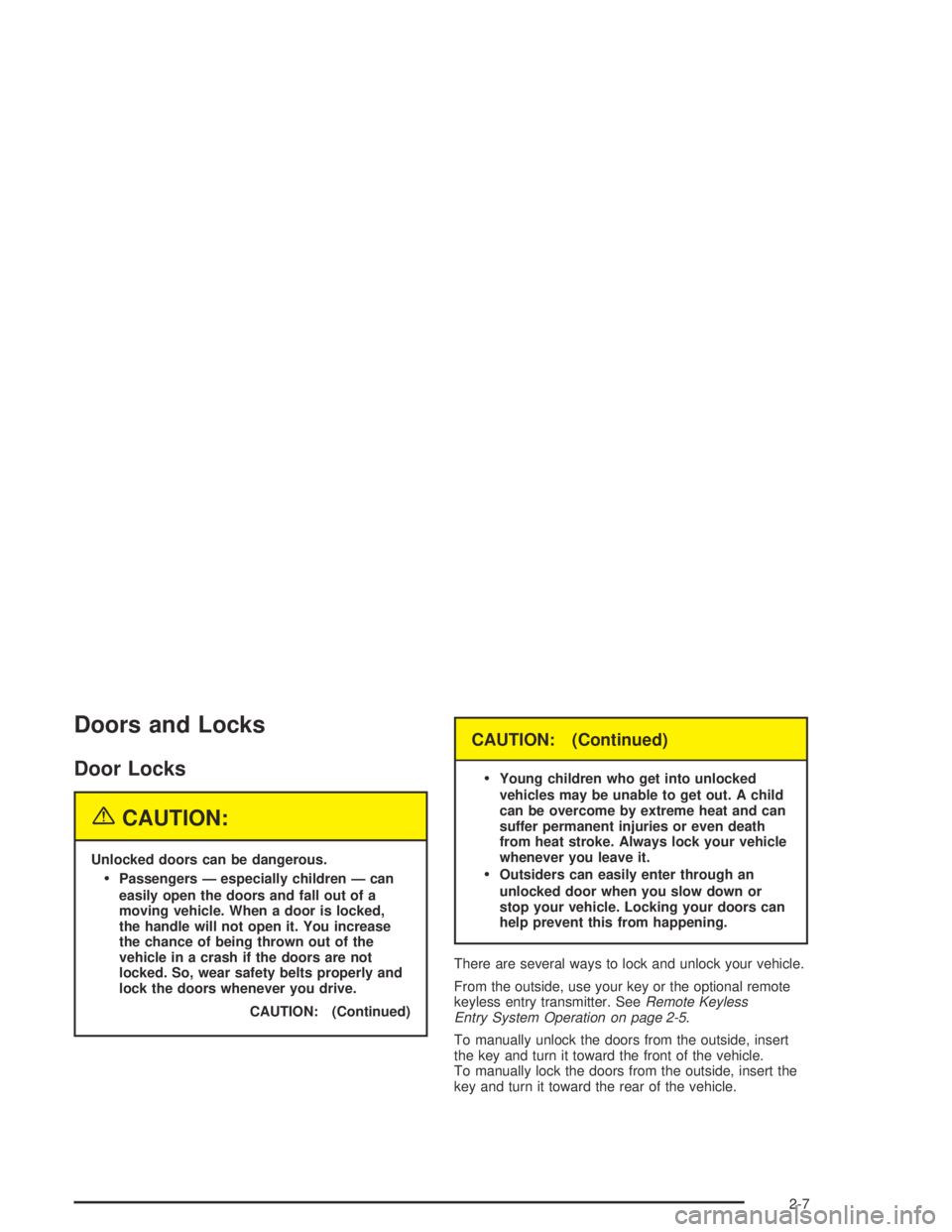
Doors and Locks
Door Locks
{CAUTION:
Unlocked doors can be dangerous.
Passengers — especially children — can
easily open the doors and fall out of a
moving vehicle. When a door is locked,
the handle will not open it. You increase
the chance of being thrown out of the
vehicle in a crash if the doors are not
locked. So, wear safety belts properly and
lock the doors whenever you drive.
CAUTION: (Continued)
CAUTION: (Continued)
Young children who get into unlocked
vehicles may be unable to get out. A child
can be overcome by extreme heat and can
suffer permanent injuries or even death
from heat stroke. Always lock your vehicle
whenever you leave it.
Outsiders can easily enter through an
unlocked door when you slow down or
stop your vehicle. Locking your doors can
help prevent this from happening.
There are several ways to lock and unlock your vehicle.
From the outside, use your key or the optional remote
keyless entry transmitter. SeeRemote Keyless
Entry System Operation on page 2-5.
To manually unlock the doors from the outside, insert
the key and turn it toward the front of the vehicle.
To manually lock the doors from the outside, insert the
key and turn it toward the rear of the vehicle.
2-7
Page 1517 of 5127
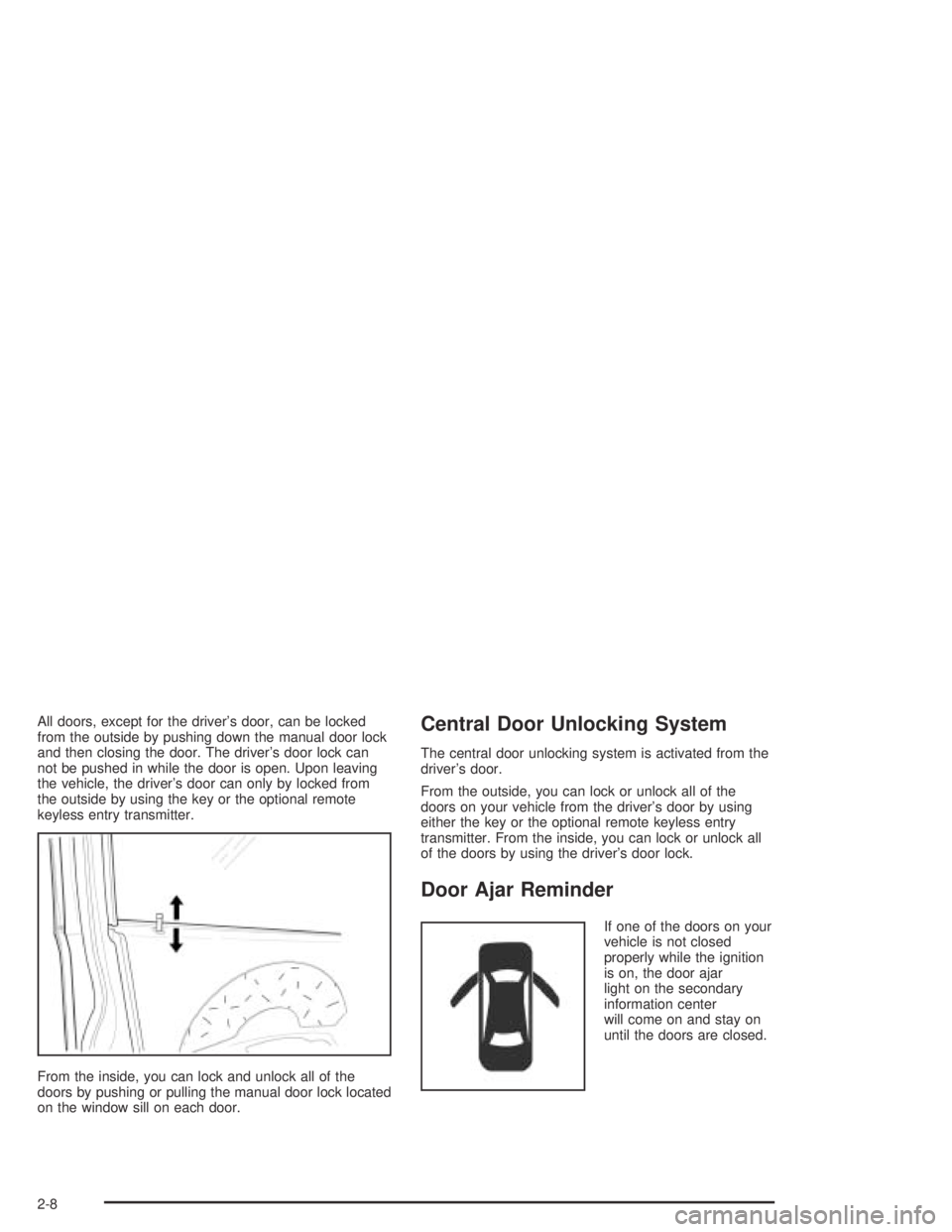
All doors, except for the driver’s door, can be locked
from the outside by pushing down the manual door lock
and then closing the door. The driver’s door lock can
not be pushed in while the door is open. Upon leaving
the vehicle, the driver’s door can only by locked from
the outside by using the key or the optional remote
keyless entry transmitter.
From the inside, you can lock and unlock all of the
doors by pushing or pulling the manual door lock located
on the window sill on each door.Central Door Unlocking System
The central door unlocking system is activated from the
driver’s door.
From the outside, you can lock or unlock all of the
doors on your vehicle from the driver’s door by using
either the key or the optional remote keyless entry
transmitter. From the inside, you can lock or unlock all
of the doors by using the driver’s door lock.
Door Ajar Reminder
If one of the doors on your
vehicle is not closed
properly while the ignition
is on, the door ajar
light on the secondary
information center
will come on and stay on
until the doors are closed.
2-8
Page 1518 of 5127
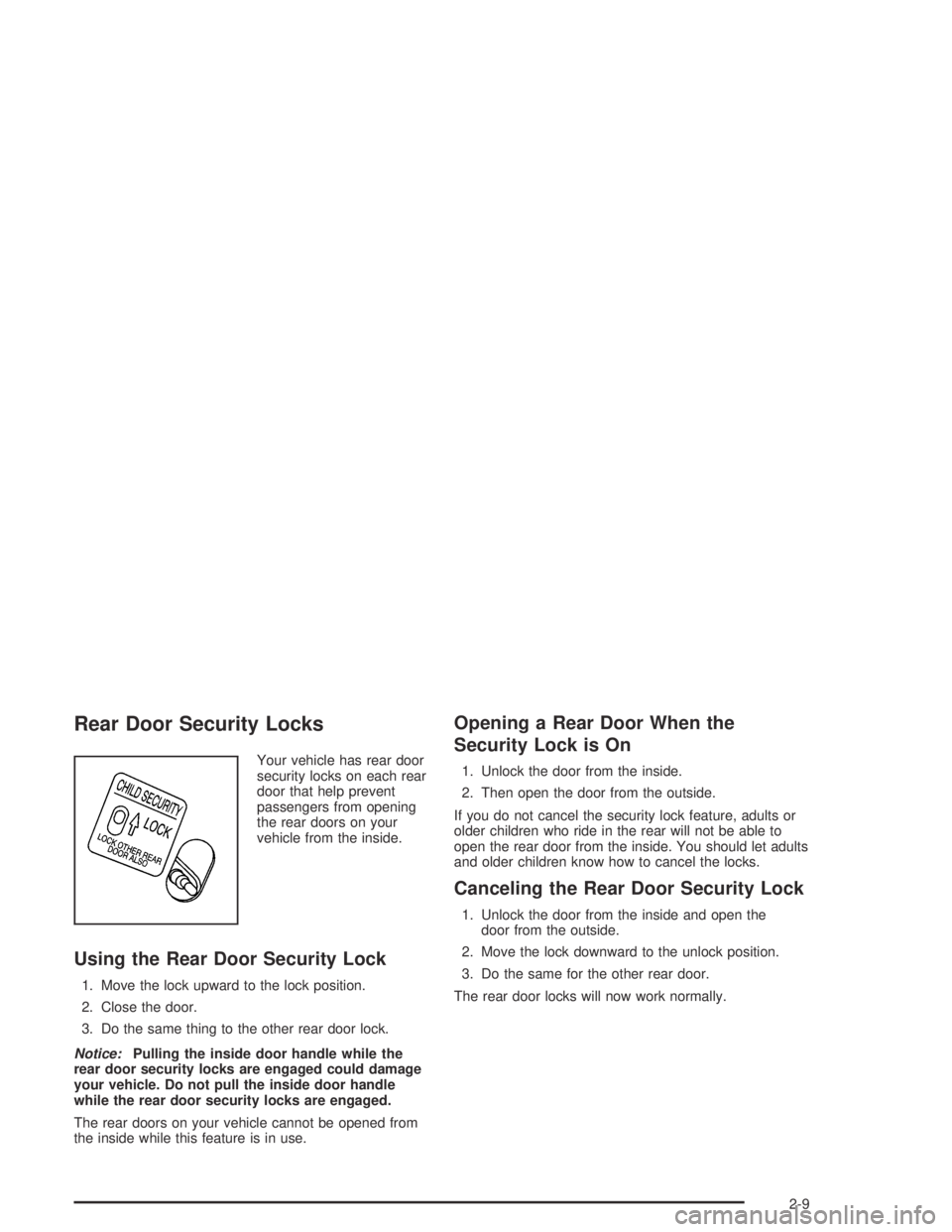
Rear Door Security Locks
Your vehicle has rear door
security locks on each rear
door that help prevent
passengers from opening
the rear doors on your
vehicle from the inside.
Using the Rear Door Security Lock
1. Move the lock upward to the lock position.
2. Close the door.
3. Do the same thing to the other rear door lock.
Notice:Pulling the inside door handle while the
rear door security locks are engaged could damage
your vehicle. Do not pull the inside door handle
while the rear door security locks are engaged.
The rear doors on your vehicle cannot be opened from
the inside while this feature is in use.
Opening a Rear Door When the
Security Lock is On
1. Unlock the door from the inside.
2. Then open the door from the outside.
If you do not cancel the security lock feature, adults or
older children who ride in the rear will not be able to
open the rear door from the inside. You should let adults
and older children know how to cancel the locks.
Canceling the Rear Door Security Lock
1. Unlock the door from the inside and open the
door from the outside.
2. Move the lock downward to the unlock position.
3. Do the same for the other rear door.
The rear door locks will now work normally.
2-9
Page 1519 of 5127
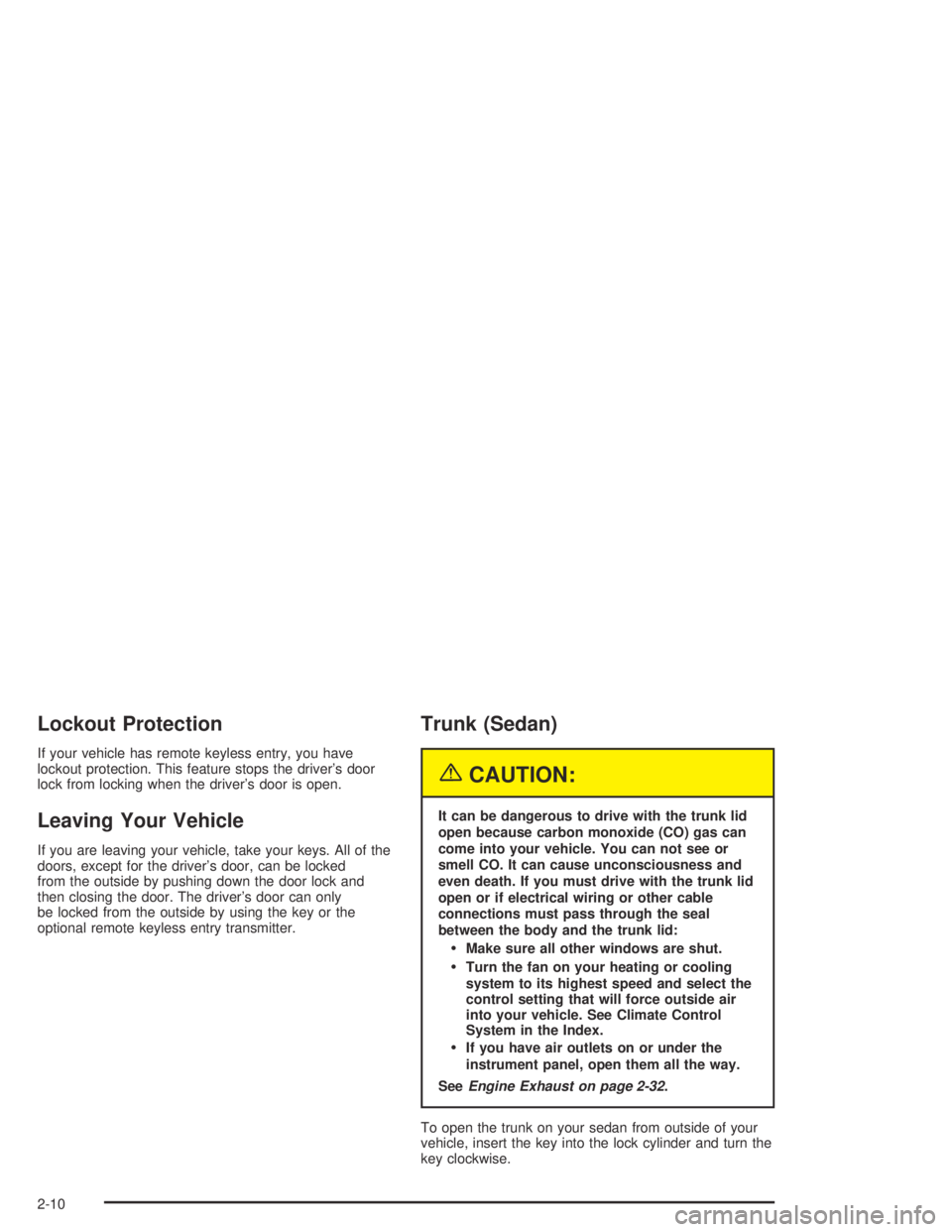
Lockout Protection
If your vehicle has remote keyless entry, you have
lockout protection. This feature stops the driver’s door
lock from locking when the driver’s door is open.
Leaving Your Vehicle
If you are leaving your vehicle, take your keys. All of the
doors, except for the driver’s door, can be locked
from the outside by pushing down the door lock and
then closing the door. The driver’s door can only
be locked from the outside by using the key or the
optional remote keyless entry transmitter.
Trunk (Sedan)
{CAUTION:
It can be dangerous to drive with the trunk lid
open because carbon monoxide (CO) gas can
come into your vehicle. You can not see or
smell CO. It can cause unconsciousness and
even death. If you must drive with the trunk lid
open or if electrical wiring or other cable
connections must pass through the seal
between the body and the trunk lid:
Make sure all other windows are shut.
Turn the fan on your heating or cooling
system to its highest speed and select the
control setting that will force outside air
into your vehicle. See Climate Control
System in the Index.
If you have air outlets on or under the
instrument panel, open them all the way.
SeeEngine Exhaust on page 2-32.
To open the trunk on your sedan from outside of your
vehicle, insert the key into the lock cylinder and turn the
key clockwise.
2-10